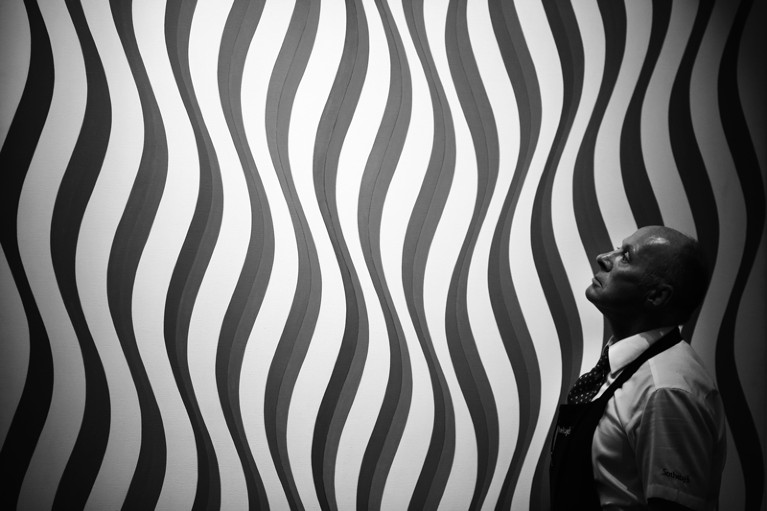
Asymmetry — seen here in the work of Bridget Riley — could offer common ground between science and art.Credit: Dan Kitwood/Getty
Those who believe that art and science share common ground (and not everyone does) often point to the concept of symmetry. Science, from fundamental physics to developmental biology, prizes symmetry, and Plato equated it with beauty and harmony. Still, art built on geometric symmetry is rare: even the blockish abstract paintings of Piet Mondrian and the psychedelic art of Bridget Riley have scant use for planes of reflection.
There’s a much stronger case to be made for asymmetry as a point of intersection. It’s a case bolstered by an intriguing conference held in France this week. The First European Asymmetry Symposium in Nice has a vigorously transdisciplinary programme, which aims to focus and encourage research on asymmetry in systems as diverse as the mouse zygote and market economies, chemical structure, Japanese art and neuroscience.
For all their celebration of symmetry in the laws of nature, physicists conjure more from its breaking. The four fundamental forces are presumed to stem from successive symmetry breakings in the very early Universe, and all the riches of condensed matter and crystallography spill forth from reductions of symmetry. The same is true in biology, in which a progressive elaboration of form is a feature of both evolution and development.
It was the symmetry breaking of a presumed-spherical egg that motivated Alan Turing to develop one of the most fertile models for the emergence of form from uniformity, in 1952. He might not have been right about that aspect of morphogenesis, but his model does explain other types of biological patterning, from animal markings to the ridges of the canine palate. The same ideas reach across disciplines to account for patterning in chemical mixtures and windblown sand.
More surprisingly, perhaps, asymmetry could be fundamental to aesthetics, too — perhaps reflecting what the art historian Martin Kemp calls a ‘structural intuition’ that lets us discern vitality in organic form; by contrast, geometric perfection creates a sense of sterility.
“There is no excellent beauty that hath not some strangeness in the proportion,” said Francis Bacon (the seventeenth-century philosopher, not the twentieth-century artist, although the latter might well have agreed). Symmetry, once grasped, loses any capacity to surprise us.
The value of asymmetry in molecular science is well established. Louis Pasteur postulated the idea of molecular chirality (to describe molecules whose mirror-image forms cannot be superimposed on each other), and chemistry has pursued the idea almost obsessively since. For synthetic chemists, this particular asymmetry is a maddening challenge: natural molecules are full of chirality, but it’s very difficult to produce one form selectively.
As Pasteur concluded, chirality has a central role in life’s mysterious origin: the puzzle of why, for example, all chiral amino acids in proteins are of the left-handed variety remains unresolved. (Ditto the right-handedness of nucleotides and DNA’s right-handed helix.) Why was symmetry broken, and was it by chance or necessity? Did the fundamental asymmetry of physics — the left–right ‘parity’ violation by the weak force — play a part in biasing the outcome?
Such questions are always worth revisiting. Whether they will mean much to the economists and linguists at the Nice meeting, say — to whom asymmetry typically means non-reciprocity of inter-agent relations and has nothing to do with spatial structure — remains to be seen.
Arguably, there is more common ground here with physicists studying topology, whether in the connectivity of complex networks or in the handedness of electron band structures of ‘topological matter’.
Still, in that multiplicity of meaning lies much of the attraction of asymmetry. When symmetry is broken, choices are made: which forking path to take? Why enter this valley and not that one? Why these laws and not those? Why (it seems) more matter than antimatter? Why is quantum spin ‘up’ and not ‘down’?
Making such choices between alternatives, when neither is obviously preferable, is often a dilemma for artists, too. Perhaps what is truly unifying for artists and scientists is the realization that, of all the many possible worlds, asymmetry makes the actual one unique.

 The architecture of structured DNA
The architecture of structured DNA
 Thomas Kibble (1932–2016)
Thomas Kibble (1932–2016)
 A constant problem
A constant problem





